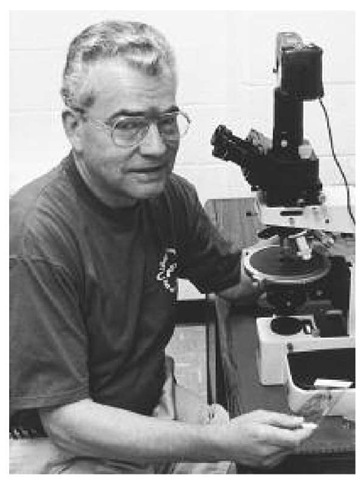(1947- ) BritishMetamorphic Petrologist
One segment of the rock cycle contains the transformation of metamorphic rocks into igneous rocks by heating and melting. However, it is not quite so simple. Because minerals melt at different temperatures and pressures, there is a point where rocks are part newly melted material and part old metamorphic rock. Once crystallized, these rocks are called migmatites (mixed rocks) and composed of minimal melts of granitic composition called leucosome and leftover metamorphic rock called melanosome. Migmatites are important in the genesis of granites but also extremely complex both chemically and in the way they deform. Michael Brown has taken the challenge to research these complex rocks and has firmly established himself as one of the foremost experts. This work began with his doctoral dissertation on the St. Malo Migmatite Belt in northeastern Brittany, France. He extended this work to southern Brittany but also to basement rocks in Timor and Proterozoic rocks in peninsular India and more recently in the northern Appalachians and in Pro-terozoic rocks from Brazil. In the Appalachians, the studies include work on contact metamor-phism around plutons in Maine, whereas the other studies are largely on regionally metamorphosed rocks. The chemical complexity of these rocks involves the melting reactions and concentrations of incompatible elements which do not fit easily into common rock forming minerals. The structural complexities result from the deformation of liquid rock sandwiched between layers of gumlike “solid” rock. Common techniques that are used on solid rocks do not work well on migmatites.
Michael Brown has a research interest in the genesis and emplacement of granitoid plutons. He conducted research on plutons in the Channel Islands between England and France, the Qoqut granite complex in Greenland with the Geological Survey of Greenland, plutonic rocks of the Ata-cama Region of Chile with the Servicio Nacional de Geologia y Mineria de Chile, and on granite plutons in Maine with support from the National Science Foundation. The investigations into the genesis of these plutons is largely an extension of the work on migmatites in that they can act as the source of magma. This research involves detailed whole rock and mineral geochemistry, as well as isotope geochemistry. He also studies the mechanics of the emplacement of the granite plutons and the contact metamorphism they impose upon the country rocks. Many of these plutons were em-placed into regions undergoing strike-slip deformation producing intriguing geometries.
Michael Brown was born on March 19, 1947, in Hayes, Middlesex, England. He attended the University of Keele, United Kingdom, where he graduated with a bachelor of arts degree with double honors in geography and geology and minors in chemistry and politics in 1969. He remained at University of Keele for his graduate studies and earned a Ph.D. in geology in 1974, supported by a National Environment Research Council Studentship. Brown accepted a position as lecturer at Oxford Brookes University in 1972. He became department head in 1982. In 1984, he moved to Kingston University, United Kingdom, as head of the School of Geological Sciences. He also served as assistant dean of academic affairs from 1986 to 1989. Brown moved to the United States in 1990 to become the chair of the department at the University of Maryland at College Park where he remains today. Brown was a visiting professor at University of Kyoto, Japan, in 1993 and at Kingston University in 1990-1992. Michael Brown has three children.
Michael Brown works at the petrographic microscope at the University of Maryland
Michael Brown is in the middle of a productive career. He is an author of some 100 scientific articles in international journals, professional volumes, and governmental reports. Many of these are seminal works on migmatites and other highly metamorphosed rocks as well as granites. Several of these studies appear in high-profile journals like Nature. Brown has performed significant service to the geologic profession. He has served in several capacities for the Geological Society of America, the Geological Society of London, where he served as member of the council, the Mineralogical Society of Great Britain, the American Geophysical Union, and the Mineralogical Society of America. His editorial roles are also numerous. He served as founding editor of the Journal of Metamorphic Geology, subject editor for the Journal of the Geological Society of London, and coleader of the International Geological Correlation Program Project 235 “Metamorphism and Geodynamics.”

